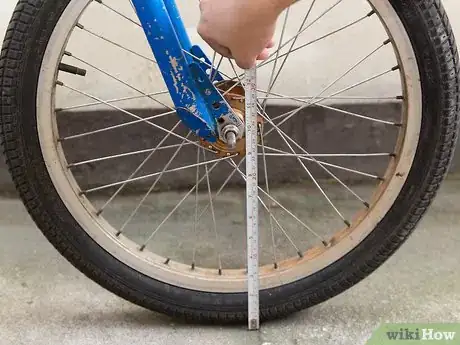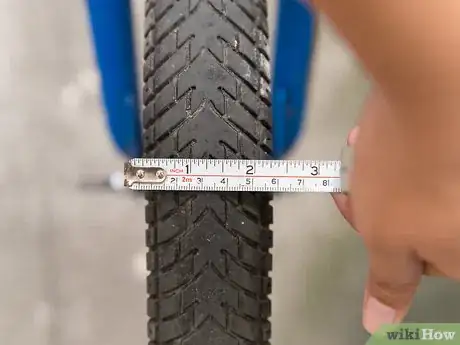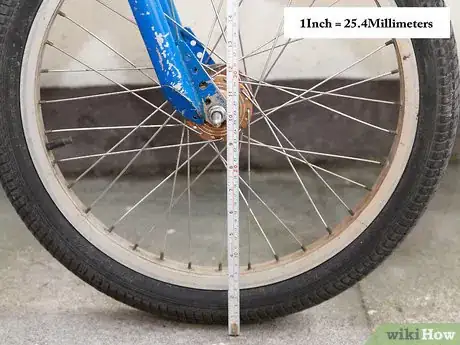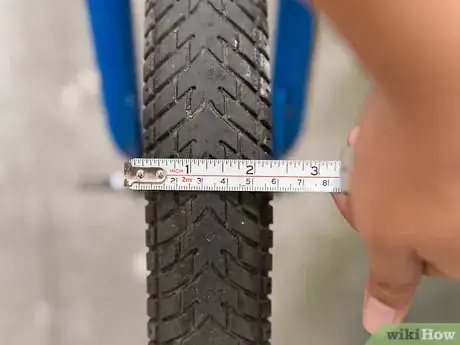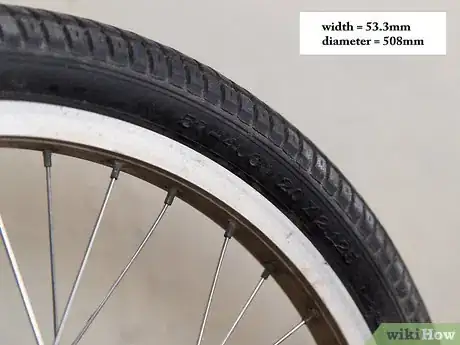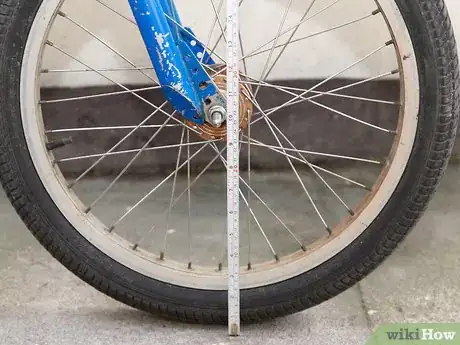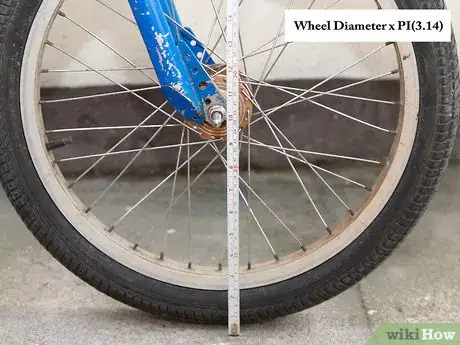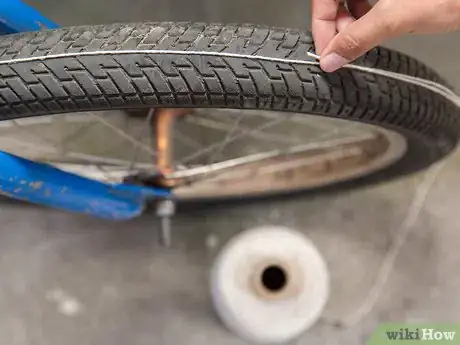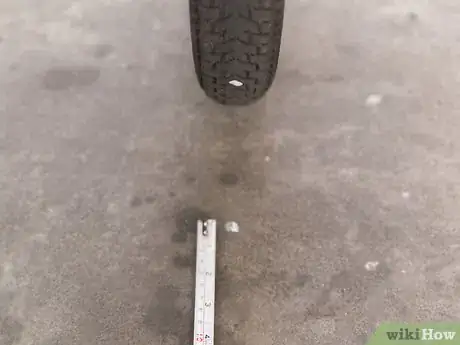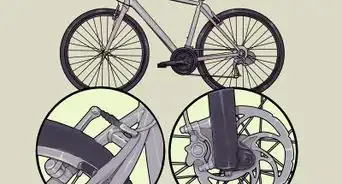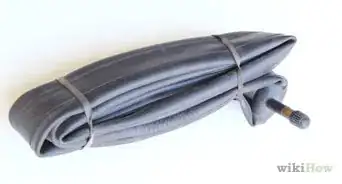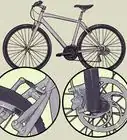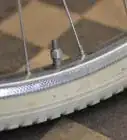This article was co-authored by Ikaika Cox. Ikaika Cox is the Shop Director at the Salt Lake City branch Bicycle Collective in Salt Lake City, Utah. He has been a bike mechanic since 2012, beginning as a volunteer with the Provo Bicycle Collective, and growing and honing his skills as a bicycle mechanic and educator in multiple Bicycle Collective locations over the years. He now leads the Salt Lake City branch of the Bicycle Collective.
This article has been viewed 573,065 times.
In order to purchase a spare or replacement tire for your bicycle, you first need to determine the size of your bicycle wheels. In fact, measuring the wheels is a standard component of bicycle maintenance. Although measuring a bicycle wheel, including determining the size of both the tire and the rim, can be accomplished by either of two methods, both are simple to complete. Sometimes you might even need to know the circumference of a bicycle wheel, which is also a simple determination that can be achieved in multiple ways.
Steps
Measuring the Tire Using the Standard Method
-
1Stand the bike upright by leaning it against a wall or using the kick stand. When the bicycle is upright, you will be able to measure the bike wheel without the bike tipping onto you. If you are measuring the bike alone, a retractable metal tape measure will be sturdier than a plastic tape measure while leaving you a free hand.
-
2Measure the distance in inches from the ground beneath the tire to the center point of the wheel. This measurement is the wheel's radius, or half of its diameter. Multiply the length by two in order to calculate the tire's diameter. With the exception of BMX models, most adult bicycle wheels are between 26 and 29 inches in diameter.[1]
- If your tire is mounted, check the sidewall to find the measurement.
Advertisement -
3Measure the flat part of the tire across the tread from one side to the other. The distance is the tire's width. It can vary greatly depending on the tire's intended use. Generally, the wider the tread, the rougher the intended terrain, while narrower treads promise a smoother, faster ride.
-
4Put the diameter first and the width second. Remember when purchasing a new tire that traditional, or standard sizes place the diameter first, followed by the width. For example, a tire sized 26 x 1.75 would have a 26-inch diameter and a 1.75-inch width across the tread. [2]
Measuring the Tire Using the ISO Method
-
1Check if your bike's wheels are measured by the ISO system. The International Organization for Standardization (ISO) measuring system uses millimeters to signify the size of your bicycle's wheel. If you don't have a measuring tape with metric rules, just be aware that there are 25.4 millimeters in one inch and determine the width with a calculator, multiplying inches x 25.4.
- ISO sizing is considered the most reliable option for measuring your tires at home. It should give you the most accurate measurement.[3]
- Most tires are measured using both the standard and ISO method. Additionally, their sizes should be printed on the sidewall of the tire so you can easily check them.
-
2Ensure the bike is propped up against the wall or on its kickstand. Measure in millimeters from the center of the wheel to only the inner edge of the tire. Once again, double the figure to determine the diameter. Most adult bicycle tires measured with the ISO system range from 650 to 700 millimeters in diameter.
- The ISO system includes both the bead seat diameter (BSD), as well as the width of the tire, in millimeters. As an example, a 700x35 c tire has a 622 millimeters BSD and is 35 millimeters wide, so its ISO designation would be 35-622. Similarly, a 26x2 inch tire would have a BSD of 559 mm and an ISO designation of 50-559.
-
3Measure the tire's width in millimeters. Use the same process listed above, across the tread from one side to the other. Keep in mind that tires of various widths can be used on the same bicycle wheel, as long as the difference is not too drastic.
-
4List the width first and the diameter second. Remember when purchasing a new tire measured by the ISO system, the width is listed first, followed by the diameter. For example, a bicycle wheel sized 39 x 700 would have tread 39 millimeters wide and a wheel with a 700-millimeter diameter from the outer edge of one side of the tire to the other. Additionally, the BSD would be 622 mm.
Calculating the Circumference of a Bicycle Wheel
-
1Measure the circumference. The circumference is the distance around the outside of a bicycle wheel, which you need in order to properly calibrate a bicycle speedometer, odometer, GPS or computer. Just as your car's speedometer and odometer will provide inaccurate data if you change the size of its wheels, bicycle equipment must also be set based on the size of your tires. [4] Whether you've just purchased a cyclometer or you need to calibrate an existing one because you've switched to tires with a different sized tread, you will need to determine the wheel's circumference.
-
2Calculate circumference easily by multiplying the tire's diameter by pi.[5] The circumference of any circle can be determined quickly if you already know the diameter of the tire from the outer edge of one side to the other. As pi is equal to 3.14, the circumference of a 26-inch tire can be reached by multiplying 26 x 3.14 to equal a circumference of 81.64 inches.
- If you already know the tire's diameter and width, you can also look up the circumference on various online charts. [6]
-
3Measure the circumference with a string. If you don't already know the wheel's diameter, you can still measure its circumference by evenly wrapping a string around the outside edge of the tire. Mark or cut the string at the spot where it reaches back to its starting point and measure its length to determine the circumference.
-
4Add a dot of wet paint to a spot on the bicycle tire's tread. Carefully push the bicycle in a straight line for at least two rotations, ensuring the paint marks the ground twice. Measure the ground from the first spot of paint to the next in order to determine the tire's circumference.
Expert Q&A
-
QuestionWhat size tires are usable on trek 26x2.0 rim?
 Ikaika CoxIkaika Cox is the Shop Director at the Salt Lake City branch Bicycle Collective in Salt Lake City, Utah. He has been a bike mechanic since 2012, beginning as a volunteer with the Provo Bicycle Collective, and growing and honing his skills as a bicycle mechanic and educator in multiple Bicycle Collective locations over the years. He now leads the Salt Lake City branch of the Bicycle Collective.
Ikaika CoxIkaika Cox is the Shop Director at the Salt Lake City branch Bicycle Collective in Salt Lake City, Utah. He has been a bike mechanic since 2012, beginning as a volunteer with the Provo Bicycle Collective, and growing and honing his skills as a bicycle mechanic and educator in multiple Bicycle Collective locations over the years. He now leads the Salt Lake City branch of the Bicycle Collective.
Bicycle Mechanic You can use any 26" (559 mm ISO) tire. However, you also need to consider the clearance inside your frame, which can vary. Your frame needs to be wide enough to fit the tire you choose. For example, if you have a 26x1.75 tire now but want to switch to a 26x2.35 tire, you'll need to make sure your frame is wide enough. Otherwise, you might get some rubbing on the tire, which can generate heat and risk your tire blowing out. Additionally, it can wear down the metal of your frame. To find out the maximum size your frame can fit, measure it, then subtract .5" or 10 mm. This leaves enough clearance for mud and dirt, as well as your tire.
You can use any 26" (559 mm ISO) tire. However, you also need to consider the clearance inside your frame, which can vary. Your frame needs to be wide enough to fit the tire you choose. For example, if you have a 26x1.75 tire now but want to switch to a 26x2.35 tire, you'll need to make sure your frame is wide enough. Otherwise, you might get some rubbing on the tire, which can generate heat and risk your tire blowing out. Additionally, it can wear down the metal of your frame. To find out the maximum size your frame can fit, measure it, then subtract .5" or 10 mm. This leaves enough clearance for mud and dirt, as well as your tire. -
QuestionHow do I remove the paint dot from my garage floor?
 Community AnswerUse brake fluid. Let it soak for a few minutes, then scratch it off with your nail or a rough sponge, SOS pad, etc. Paint thinner will work as well.
Community AnswerUse brake fluid. Let it soak for a few minutes, then scratch it off with your nail or a rough sponge, SOS pad, etc. Paint thinner will work as well. -
QuestionCan I replace a 700/25 tire with a 700/26 on a road bike?
 Community AnswerAlmost definitely. The only real issue when going to a wider tire is clearance around the frame, but such a small difference shouldn't be a problem.
Community AnswerAlmost definitely. The only real issue when going to a wider tire is clearance around the frame, but such a small difference shouldn't be a problem.
Things You'll Need
- Measuring tape
- Calculator
- Bicycle or bicycle wheel/tire
References
- ↑ http://www.menomonee-falls.org/755/How-to-Measure-a-Bicycle-Tire
- ↑ http://www.sheldonbrown.com/tire-sizing.html
- ↑ https://www.sheldonbrown.com/tire-sizing.html
- ↑ http://www.sheldonbrown.com/cyclecomputer-calibration.html
- ↑ http://www.analyzemath.com/trigonometry/ang_lin_speed.html
- ↑ http://www.bikecalc.com/wheel_size_math
About This Article
To measure a bicycle wheel, start by standing the bike upright by leaning it against a wall or using the kickstand. Then, use a tape measure to measure the distance from the ground underneath the tire to the center of the wheel to get the radius. Next, multiple the radius by 2 to get the diameter. For example, if you measure 14 inches from the ground to the center, the diameter is 28 inches. Finally, measure the flat part of the tire across the treads to find the width measurement. To learn how to find the circumference of your bicycle wheel so you can calibrate your speedometer or GPS, read on!

